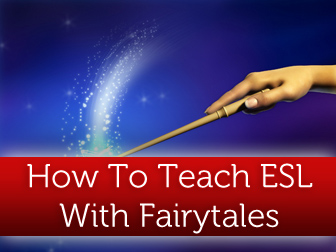Once upon a time in a land far away lived a beautiful princess. She was unhappy because her parents would not let her out of the castle, and she wanted more than anything to explore the world. One day a little man came to her in the castle garden….
This is not a traditional fairy tale, but whether you use stories your students have heard a thousand times or you write your own, fairy tales can be an fun and engaging way to teach English. With the following exercises, you can teach a unit on fairytales and have your students write their own as part of the process.
How to Teach ESL with Fairytales
-
1
Once Upon a Time
Kids love to listen to fairytales. There are stories upon stories starting with, “Once upon a time…” and ending, “and they lived happily ever after.” Starting your class by reading some familiar fairytales will engage and entertain your students. After reading these stories, ask your students what each of them has in common. You should look for answers such as they are make believe, they all have good characters and bad characters, they all use similar words at the beginning and the end of the story, and often the characters receive magical help. Working as a class, brainstorm fairytales they might know from either reading or watching movies. Encourage students to share any fairytales they know from their home cultures and languages as well. You can ask students to give a one-sentence summary of the fairytale during brainstorming but encourage them to give a more detailed explanation of those fairytales in the next activity.
-
2
There Lived a Beautiful Princess
Now that you and your students have a list of fairytales, break your class into groups of four to five students each. Ask each group to look at the list of fairytales and choose one for their group. This is when students who have mentioned unfamiliar tales should give a more detailed description those fairytales. Each group should then plan to act out the fairytale in front of the class. You can give your class as little or as much time to plan the skit as you would like. If you have the time, encourage your students to discuss the story, getting in speaking practice, and then write a script for the skit, getting in their writing practice for the day. You can then have them perform the fairytale in class that day or give them more time to get costumes and other elements in place.
-
3
Her Parents Would Not Let Her Out of the Castle
Now that your students have brainstormed several fairytales and worked with one fairytale in depth, it is time for them to write their own. Help your students plan what they will write by asking these questions before writing.
- Who are the good characters in your story?
- Who are the evil characters in your story?
- What problem(s) does the main character have?
- What kind of help will the main character get?
- What magic is involved?
- How will the story end?
After getting these ideas together, your students should write their fairytales beginning with, “Once upon a time…” Students can work in pairs to give feedback throughout the writing process. If a student is still unable to create his or her own tale, allow him to rewrite a tale he already knows. If this is the only tale your student can write, ask him to choose a fairytale in his native language so that he gets more language practice as he translates it from the original. You may want to have your students read their original stories in front of the class as well.
-
4
They Lived Happily Ever After
Once your students have completed their fairytales and illustrated them (though this is optional), compile all the stories into a class book. You can make it look old fashioned and fanciful by using a simulated leather cover and a gold paint pen to write the title and class authorship on the front. Make this book available to your students during their free reading periods so they can read what their classmates have written.
You can do further activities with these fairytales by assigning a compare/contrast paper to your students. They can examine two of the original stories or compare one original story to one classic fairytale. You can also make an interclass activity by bringing younger students into the class for a fairytale themed day. Your class can dress in fanciful costumes if desired and then read their original tales to the younger students. You could also decorate your classroom to look like a castle, if you are feeling especially ambitious, and provide snacks for your visitors.
Teaching with fairytales is fun and engaging and gives your students an opportunity to share a little of their cultural history with the rest of the class as well as their imagination.
Encourage your students’ creativity by teaching with fanciful tales and letting them tell their own. You may just live happily ever after, too.
P.S. If you enjoyed this article, please help spread it by clicking one of those sharing buttons below. And if you are interested in more, you should follow our Facebook page where we share more about creative, non-boring ways to teach English.








